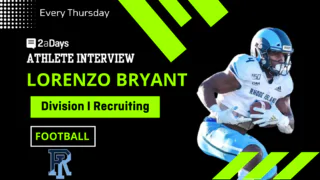It's a long path from high school golf to Division I.
According to the National Federation of State High School Associations, only 2 percent of all high school male athletes make it to the Division I level. So, we've compiled these following tips to help you join that 2%.
Tip 1: Play Tournament Golf
Playing in tournaments gives you a chance to improve your skills, practice your competition, get in front of recruiters, and improve your rankings.
John Felitto, a former Notre Dame golfer, talks about the importance of playing tournament golf: “The best way to get recruited is to play tournament golf as often as you can. Regardless of an event's status or prestige, competition is always king. The more often you play, the more often you are allowing yourself to break through.”
Related school rating: Notre Dame University
Tip 2: Be Specific
Being as specific as you can when reaching out to a coach shows your genuine interest in the program. Please do your research and follow the team on their website. The more you know about the team's program, the more prepared you will be to make a phone call or write an email or letter to the coach.
Penn State golfer Ryan Davis said it best: “I'd say pick a handful of schools that are a realistic fit and personally reach out to them. The more specific you can get about a University in a letter/email, the better. College coaches hate generic emails that are sent to 100 schools, and they can easily tell the two apart.”
Conclude the email with tournaments you will be playing in and a swing video. Finally, leave your contact information and some available times in case the coach wants to set up a phone call. This is a great way to start building a strong foundation and relationship with the coach.
Related: Example Email to College Coaches
Tip 3: Organization is Key!
If you can plan out your tournament schedule and let the coach know which events you will be playing in, it will make the coach's job easier. He or she will be able to pay attention to the leaderboard, but more importantly, the coach may travel to watch you play.
Planning your weekly schedules between practice time, workouts, and days off will also help you create structure and become accustomed to busy schedules you will face at the collegiate level.
Ryan Davis states, “Managing your time effectively is the best way to set yourself up for success. DI sports require a huge time commitment between practice, workouts, travel, and a full class schedule. If you can't manage your time well, it's going to be hard to improve in your respective sport.”
Related: Tips to Prepare for Competitive Golf
Tip 4: Send Swing Videos
As much as college golf coaches like to see low golf scores, they also like to see a recruit's swing and short game. While a coach would like to see you play at a tournament, they may not get the chance to see you in-person. So, it may be in your best interest to send multiple angles of your swing and your short game in an email. Some coaches like to pay attention to technique, and they can learn a lot just from watching your swing on film.
Coach Dennis Shea, who recently just retired after 26 years at Monmouth University, says “You can evaluate many fundamentals such as alignment, grip, tempo, and balance. Most potential college players have good videos, and it is in the best interest to send videos face on as well as multiple shots of short game swings.”
If you send a swing video early on in your recruiting process, a coach can see the progress or changes you have made as well. Coaches love when a recruit is honest and transparent about their game.
Related: Dos and Don'ts of Highlight Videos
Tip 5: Study!
It can be easy to let sports distract you from school, but getting into a good school will rely as much on your academics as athletics.
If coaches know you are a talented golfer and want to recruit you, having good grades can increase your chances of being accepted by the school and potentially lead to more scholarship money. In college golf, there are 4.5 scholarships per year, which often means that coaches are only able to offer partial scholarships to each member of the golf team. If you have good grades and a high SAT/ACT score, you can enhance your partial athletic scholarship with an academic scholarship.
Related: Pro Tennis Player, Kristie Ahn, on Academics and the Recruiting Process
Tip 6: Enjoy the journey!
You are playing a sport you love! It can be easy to get caught up in the rankings, your scores, making decisions, and scholarships. At the end of the day, a good coach will love to hear your mindset about improving as a golfer and improving yourself as a person on and off the course. Just remember why you started playing the game in the first place and enjoy all the beautiful lessons that this game has to offer!
* Originally published on October 7, 2021, by Jimmy Criscione







